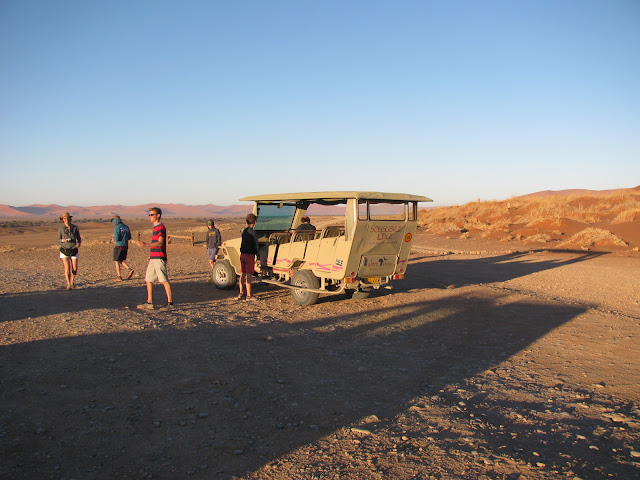We then drove the last 100 km or so to the Bagatelle Kalahari Game Ranch which is 40 km outside of the town of Mariental. The drive through this area was primarily very flat range land used for grazing cattle, goats, and sheep. Change the vegetation to sage brush and it would be like driving through rural Nevada. This part of the country is one of the primary areas where the government implements its land reform policy. The policy is designed to address some of impacts of colonialism and apartheid by returning landownership to qualified blacks. It is based on a "willing seller, willing buyer" philosophy where the government will buy land from the private white owners and then give it to black families whose ancestors where displaced under colonial rule. Each family gets a plot of land (the ones we saw appeared to be 10 acres or so) to farm or ranch - kind of like homesteading. Unfortunately, the farms we passed had corrugated metal shacks for housing and too much livestock for the size of the plots which have been overgrazed. Unfortunately, a lot of these farms will be unproductive in not too many years.
Mariental itself is the heart of the commercial scale agricultural region called the Hardap Scheme. It was the first area that we saw large, sprinkler irrigated crops similar to the US. They grow a lot of citrus fruit, corn, and crop vegetables. It is controversial because of all of the water that is used.
Bagatelle Kalahari Game Ranch is situated on the far western edge of the Kalahari desert. The ranch was the most touristy accommodation that we have stayed at so far in Namibia. They had horseback riding, a Sans or Bushman village replica, a restaurant where a springbok antelope wandered around, etc. It was also the most expensive place that we have stayed. We rented a private bungalow that overlooked the Kalahari desert. It was built on stilts to overlook the sand dune - similar to a beach house.
 |
| View of Kalahari from the room - There was a water hole right in front |
The Kalahari desert, at least in this area, consists of low red sand dunes covered with savannah types grasses. The red sand is actually what is transported by the wind and erosion to make the dunes seen in Sossusvlei.
 |
| The Kalahari Desert |
 |
| Meekcat Burrow and Mound |
 |
| An interesting tree. Note the large tap root in the center. |
Our trip ended with a 240 km drive back to Windhoek (all on paved roads). So, over the course of our trip (800 km) we saw terrain that varied from the desert dunes of Sossuvlei...
To the rugged Naukluft Mountains...
To plateaus and canyon lands...
To wide open vistas...
To the Kalahari Desert.....
To open savannahs......
With lots of solitude. And that's just the central part of Namibia. It really is a beautiful country.













































